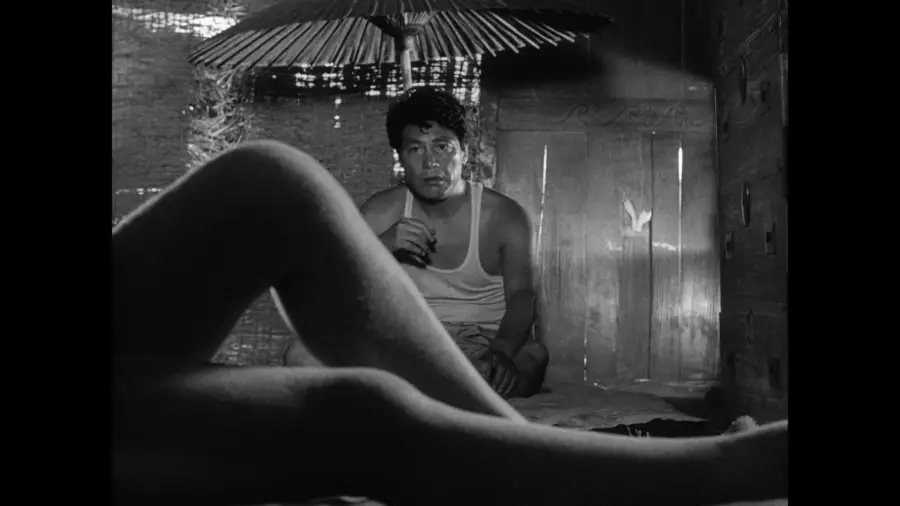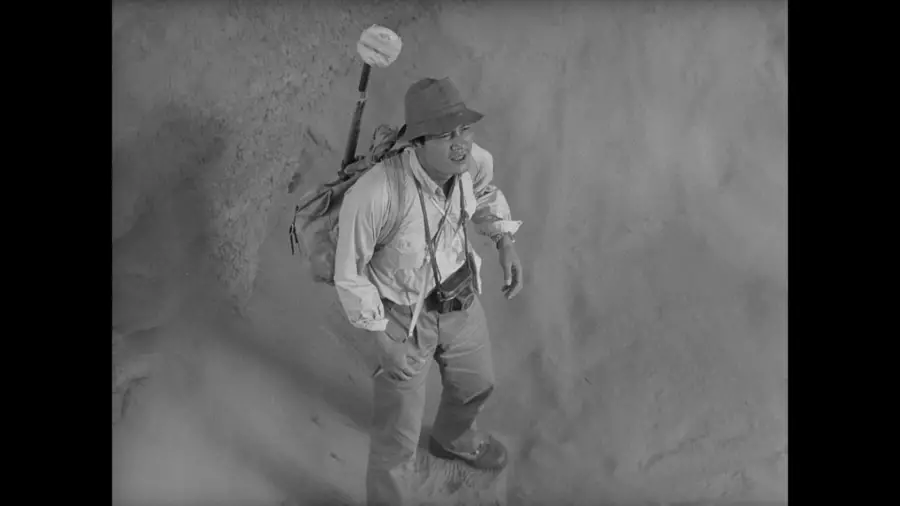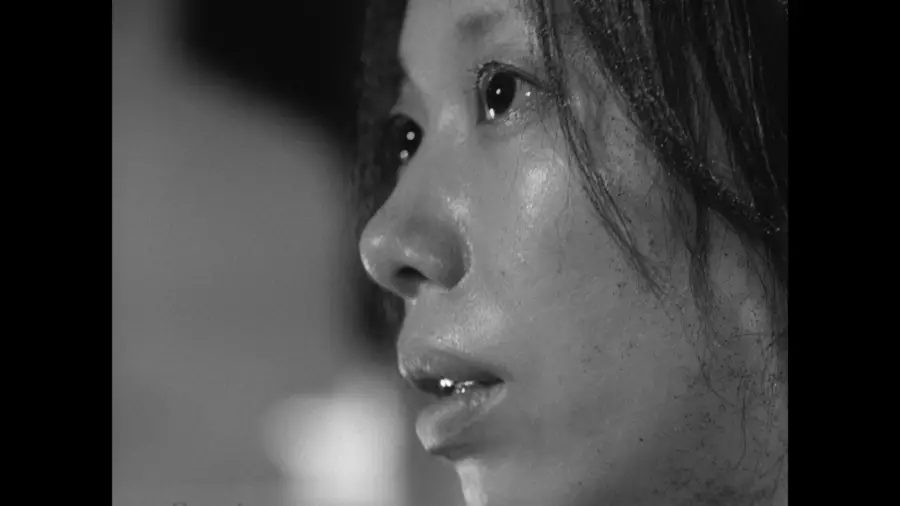Woman in the Dunes

See more details, packaging, or compare
Synopsis
One of the 1960s’ great international art-house sensations, Woman in the Dunes was for many the grand unveiling of the surreal, idiosyncratic world of Hiroshi Teshigahara. Eiji Okada plays an amateur entomologist who has left Tokyo to study an unclassified species of beetle found in a vast desert. When he misses his bus back to civilization, he is persuaded to spend the night with a young widow (Kyoko Kishida) in her hut at the bottom of a sand dune. What results is one of cinema’s most unnerving and palpably erotic battles of the sexes, as well as a nightmarish depiction of the Sisyphean struggle of everyday life—an achievement that garnered Teshigahara an Academy Award nomination for best director.
Picture 7/10
Criterion, rather oddly, breaks up their out-of-print Hiroshi Teshigahara box set (which contained Pitfall, Woman in the Dunes, and The Face of Another) and presents the director’s Woman in the Dunes on Blu-ray, delivering the film in the aspect ratio of 1.33:1 on this dual-layer disc. The 1080p/24hz presentation comes from a high-definition scan of a fine-grain master positive.
It looks as though this is the same master used for the previous DVD edition, and if that is the case it holds up very well. The old DVD still looks pretty good but the improvements here still manage to be obvious. The level of detail is certainly impressive, especially in its delivery of the granules of sand on display throughout the film: many shots, whether they be of sand on one of the character’s body or the sand that endlessly rolls down the cliff sides, you can just about make out every little spec. Contrast levels look fairly good and shadow details come through fairly well in darker scenes. Objects are cleanly rendered and distinct, and the image remains consistently sharp.
It looks like further restoration has been done in comparison to the older DVD and the image here is virtually flawless in terms of print damage, only a handful of blemishes here and there. The rendering of the film’s grain is open to a bit of improvement but it’s not a noisy, blocky mess. A couple of tighter patterns (a scarf with a polka dot pattern, for example) give off a shimmer but it’s mild and not at all common.
The upgrade, in the end, is very good, an improvement over the older DVD, but there is still some room for improvement.






























Audio 6/10
The film’s Japanese soundtrack is delivered in lossless PCM 1.0 mono. The overall quality is fine, though there is an obvious bit of static throughout most of the film, which can periodically become a bit louder and becomes more apparent during quiet scenes. There’s also noticeable distortion when the film’s score reaches the higher ends of the spectrum. I didn’t notice any other bits of damage and dialogue at least sounds clear.
Extras 8/10
Previously available exclusively in Criterion’s box set, Three Films by Hiroshi Teshigahara, the set as a whole was discontinued a couple of years ago with the belief by some (though with no confirmation) it was being upgraded to Blu-ray. Now, with only one film from the set being release, I do somewhat worry that may not be the case. Each film in the set (which also included Pitfall and The Face of Another) featured the film’s trailer and then a visual essay by James Quandt specific to each film. There was then a fourth disc featuring a number of other supplements. What Criterion has done here is not only carry over the Woman in the Dunes specific features to this release, they’ve actually carried over all of the supplements from the fourth disc of that set as well, placing them on this title. The reason I find that a bit worrying is that it not only seems to suggest that Criterion has no plans to update the set as a whole for Blu-ray, but they might not be in a hurry to upgrade the other two titles in the set as well, which would be an incredible shame (though, true, the film specific supplements related to the other films in the set are not here, it still doesn’t leave a lot of material for future Blu-ray editions for those films, unless new material is dug up).
At any rate we do still get a strong set of material. James Quandt’s visual essay on the film is the first item to be carried over (naturally his visual essays for Pitfall and The Face of Another have not been). The visual essay, which runs about 30-minutes, comes off as more of a commentary in nature that happens to play over scenes from the film that sometimes correspond to what he is talking about, and he focuses on the philosophical nature of the film in terms of identity; this was a main focus in the DVD box set—hence the fingerprint image on the release’s artwork—and it was carried out through his essays for each of the films. On top of that topic he also talks about the various reactions to the film at the time of its release and over the years, showing the many interpretations, which range all the way from a Taoist interpretation to a totalitarian interpretation. He compares the film to Pitfall and The Face of Another, though primarily in how the film is really the more straightforward narratively in comparison to the other two, and also how it fits in with Japanese cinema of the time, making many comparisons between Teshigahara and director Shohei Imamura. One point of interest is Quandt does talk about a shorter 123-minute version, though he unfortunately doesn’t give more detail about how the film was cut down. It’s a fine enough essay that I rather enjoyed and it works in helping one work out their thoughts on the film, though I still found all three essays from the original box set to work in one harmonious piece.
(This feature, and the next one, are both upscales of the previous standard-definition presentations, with the clips from the film looking more like what was on the DVD edition, which actually allows one to compare the new presentation to the old one if one felt inclined.)
From the fourth supplement disc of the DVD set comes the remaining supplements, starting with the 35-minute documentary Teshigahara and Abe, featuring interviews with critics/programmers Richard Peña, Donald Richie, and Tadao Sato, as well as set designer Arata Isozaki, producer Noriko Momura, and screenwriter John Nathan. The documentary offers a bit of an analysis into why Teshigahara got into filmmaking and why he eventually got out of it (it’s all related quite tightly to Teshigahara’s father, Sofu Teshigahara, and his flower arrangement school, the Sogetsu School of Ikebana). But it focuses primarily—of course—on the working relationship between the director and author Kobo Abe and how their visions seems to perfectly align despite the different mediums they worked in. It’s an excellent piece on both the collaboration of the two and the filmmaker’s own career.
Criterion then carries over the four short films found in the previous box set, though they’re each presented in high-definition in this case. The first three could be considered short documentaries of a sort. Hokusai (1953, approx. 23-minutes) tours a museum’s display of woodblock artist’s Katsushika Hokusai work, offering a history of the artist and the time period the art represents through its narration and onscreen text. We also get a piece on his father’s school in Ikebana (1956, approx. 33-minutes), the lone colour short here, offering a look at the classes, the students, and the work that comes out of it.
Tokyo 1958 (1958, approx. 24-minutes) is a collaborative film made with eight other filmmakers: Susumu Hani, Yoshiro Kawazu, Kyushiro Kusakabe, Sadamu Maruo, Kanzaburo Mushanokoji, Masahiro Ogi, Ryuichiro Sakisaka, and Zenzo Matsuyama. I’m not sure how much Teshigahara had with this (from what I have read on the film he sounds to have been the lead on the project), which weaves together a collection of footage covering Tokyo at the time, sometimes in a fairly experimental way.
The previous three show Teshigahara experimenting with image and sound using real life subjects to focus on. The fourth film, Ako (1965, approx. 29-minutes) is the sole fictional narrative here, which is actually also based on one of Abe’s stories. Here Teshigahara takes what is, at first sight, a rather simple story following a 16-year old girl and her friends, but the director adds his own twist giving the film, when appropriate, a slight bit of unease. The film was also part of a larger omnibus film, La fleur de l’age ou les adolescents.
The theatrical trailer for Woman in the Dunes closes off the disc. The release also comes with a booklet featuring Audie Bock’s essay on the film that first appeared in booklet included with the previous DVD box set. The booklet also features a reprinting of an interview with Teshigahara conducted by Max Tessier for his book Le cinéma japonais au présent: 1958-1984. Obviously none of the other essays covering the other films in the box set appear here.
So ultimately this release features a nice wealth of material and I’m glad Criterion at least carried over the box set material over. Unfortunately I’m not sure what this says about the possibility of Blu-ray releases for the other films in the set.
Closing
There’s an obvious disappointment Criterion has chosen not to simply upgrade the entire Teshigahara box set from DVD, and I can’t say why they chose this film specifically since it doesn’t appear they’re using a new transfer or restoration: as far as I can tell it’s the same one used for the DVD with some further restoration work performed. Ignoring this, though, on its own it’s still a rather nice release, offering a noticeable upgrade over the DVD and the supplements are all very good. Certainly worth picking up, even if you already own the out-of-print DVD box set.







